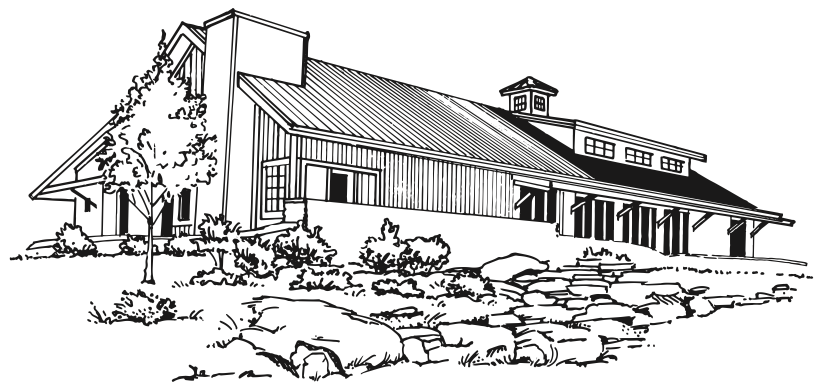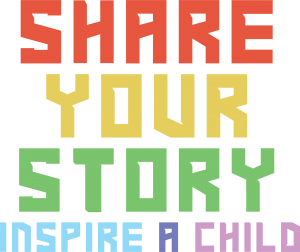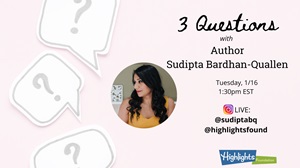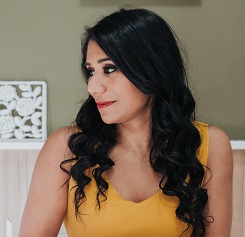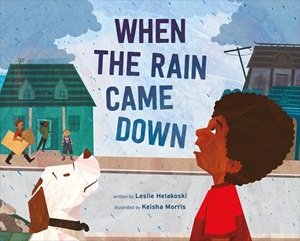Full Transcript:
Cat: A big hello to our Highlights Foundation family. We’re so happy to have you here with us. For those that may not know me, I’m Cat Galeano. My pronouns are she/her and I’m the social media manager at the Highlights Foundation, joining you from Westchester, NY, on the traditional lands of the Siwanoy people. I’m also a writer AND a reader who is very excited to have this lunchtime chat with our friend and faculty, Sudipta Bardhan-Quallen, where we’ll talk a little bit about her upcoming mini course Revise to Resonate: Your Picture Book Plot, Pacing, and Character.
Now let’s get started. My first question for you is what I personally loved about this course is that the revision strategies you’re going to cover are things that some writers assume, assume that they have to get right on a first draft. But that’s not the case. Things like character development, emotional resonance and pacing can be sparked in a first draft. But then revision is there, where you can bring it all out and make it better. Does that mirror your own process? When do you usually get that feeling like, OK, this manuscript could be something.
Sudipta: Alright, well, let me, let me answer the second part first. In terms of like that decision tree we make on whether we should continue with the project. For me, there’s a bunch of different points where I evaluate that question.
The first point is actually before I start writing, I need to come up with my short 25 to 50 word pitch in my own head of what the story is going to be about because that really helps me zero in on what I want to explore, right? So it isn’t “Well, I kind of want to write a story about a Dog and maybe the dog would wear a tutu. No. I’ts going to be “it’s a story about a pampered pug who thinks that she needs to be taken care of but learns that she can actually take care of herself. That’s my pitch, right?
And now I have an idea of what this book is going to be. And I know what the heart of it is. That’s my first point. There are lots of, lots of ideas that actually never get to that point. Like I can’t, I can’t articulate what that concise idea is. And with a picture book, if you can’t articulate a concise idea, it is not going to end up being the size a picture book needs to be. So that’s the first point.
And then after that I do draft without, without revising first I, my first draft is usually less about character or emotion or theme. My first draft is about getting all the scenes into place for the plot, right? I think about just how am I taking my character from point A to point B. I don’t worry about: “Am I thinking about the characters emotions?” “Am I getting enough heart?” I’m just thinking about what are those scenes that are going to establish this.
Sometimes you get those other layers in from muscle memory. I’ve been doing this now for 20 years, 20 plus years and so there are things now I catch myself just kind of doing because I know that they have to be done. But I’m not worried about my, my first draft. In my first draft, I’m just worried about the scenes.
Then as I’m revising, I’m starting to think about, OK. Well, if I want this theme right? If I want a theme about being able to save yourself, right. How am I going to get that across? Well, I’m going to make her feel, I’m gonna make this character feel like she’s helpless, but I’m also gonna put her as the only character in the book. Therefore, she was never going to get any help from anybody else. There’s no one else in the book to help her, right? So I’m going to be able to take out any of those extra characters in this particular story. This happens to be the story about Roxy who might make an appearance. If I can hear her.
In the first half there were other characters that you saw. In the book, there are none. No other characters, because it was really important to make sure the character knew, HAD to save herself. There was no other option. So we’re getting to those things in the revision.
I also, I feel like the theme is almost the last, the last round of revision, right? First you do plot, first you do the actual scenes. Then you start to do emotion, you start to think about how is the character feeling in all of these scenes. Are the scenes in the right order? Do I need a different scene to kind of match the emotional shape that I’m trying to create?
And then the third round iss about getting to that deeper theme. Am I really exploring this? Am I getting off topic? Am I exploring something else in here? What do I need to pare back on? What do I need to expand?
And I’m saying it like it’s three waves. It’s not three drafts as we know, right? It’s it might be twenty, it might be two, it might be twenty, right? You can’t tell, but those are theind of three phases of it for me.
Cat: Wonderful, thank you for sharing that. Um, are, my second question is do you do this type of revision first in your own process? Which you kind of spoke about, but we’ll go a little more into detail. Or do you word choice, grammar and the other stuff like that–which again, you kind of went into but I guess we’ll dive a little more into it.
And I also wanted to just mention that, like you said, it sounded like three, but it really could be twenty and that’s like the, I think the super incredible part about the picture book journey is like, sure, t’s like, you know, 500 words sometimes and super tight but also, it takes so much effort to finally get to that 500 words, like what you said. All those layers people don’t see and all those revisions and how it’s OK to go through all those steps.
Sudipta: Well, I think it’s also to remember that it’s iterative, right? So 3 phases, but when I get to the end I might have to go back and start again, with the plot and then go through the emotions and then go throug–it depends on how the story is changing. So word choice, grammar, I’m going to say something very controversial. I almost never worry about that. My first concern is the heart of the story. And I feel like some of the word choice kind of comes out of, um, the heart you want to go to, because it’s not about what the more beautiful word is. It’s thoughtful, more beautiful than concentrating. It’s really, you know, what is the right word in this moment. What is the emotion that I’m trying to get at and what’s THAT word? So I guess that is word choice, but it’s less about the sound of it or the grammar of it..well, OK always use good grammar. Don’t. There’s no excuse for not using good grammar. That’s just a given, unless unless you’re doing something deliberately not grammatical, but that’s…
OK. Now I’m being very mom. So here’s my rule, but now I’m going to give you the 17 caveats I’ve already thought of. But yeah, so I’m not thinking about that. I’m mainly thinking about what the story means, because I feel like first of all, hen you start revising with an editor, they are always going to have changes to make. It does not matter what your story is, there will always be changes.
I wrote a story once called, it was called Marco Polo. It was just a call and response between a child and his mother. He’d say Marco and to show that she was there– whether it was first thing in the morning when he was hungry or whether he was lost in the park–she’d say Polo.
And that book, you could look at it as only two words being revised, or you could look at it as 100 percent being revised. It, now, the only words are Rutabaga and Boo. So even in a book like that with two words, there were revisions to do.
So there’s a little bit of that, that you have to keep in mind. You are going to be changing the words, but what I feel like what editors want to connect to is the story and the meaning and the heart. And if that is there, the words can be reached. You can have to, you can write the most beautiful sentences, but there’s no heart there. That’s hard to do with someone else revising, when an editor’s job is kind off a different part of it, right. Yes, you will revise with an editor, but they’re revising to get you to publication, which you’re going to have to be close to publication already. If you haven’t figured out the heart, you’re not that close to publication. Yeah, does that make sense?
Cat: I love how you spoke about the heart because I feel like when you write something like if that heart is not like palpitating from the pages, like perhaps the words won’t flow or they won’t like it won’t unfold, or that story won’t kind of leave you in this place because that heart isn’t there. It’s not pulsing. It’s not, you know, moving the story along. So I love that you went into that.
And my third and final question is–which I’m already sad that we’re running out of time–what usually takes more time for you drafting or revising? Or do you do bits of both together?
Sudipta: I think it depends on what the definition of draft is, right? I feel like I write a draft. And then I realize it and then that’s my new draft, right? And then I revise it, and then that’s my new draft. But for me, I am I’m a planner, right? And I need to know what the story is going to be in my head, I need to know all the scenes before I ever sit down and write. So sometimes people ask well, how long did that book take to write? And I’m like, well, it took like a month, but it didn’t take a month. It took eight months of me thinking about it before I ever put pen to paper. And then it’s like a month that I actually do it. I do a lot of the..you know..a lot of the steps of the revision I do in my head, before I start writing. But the revising is the more important part, right? Because that’s really where, you know, that’s where you’re creating that final product. No matter what you start with, right? You can always have all the ingredients, right? But if you don’t put them together in the right way…um, you can have the flour, you can have the baking soda, you can have the the vanilla: if you don’t put it together in the right way, what you get is not going to be a cake. It’s gonna be something disgusting, right? So, understanding once I gather all those ingredients, it’s a lot easier for me then to fine tune it. And that’s how I I view, drafting is the gathering of the ingredients; revising is the putting together of the recipe right? If that makes sense.
Cat: I love that. Is there anything else you want to add? To share with our community or people that are considering taking your class anything else you want to just say last minute?
Sudipta: I think it’s really important if you want to do this work to be open to revising and to be open to other people’s suggestions. There are plenty of times I get feedback that I don’t agree with or I think is just crazy. But you have to remember that one person’s opinion represents actually a larger group than one person, right? So when someone says something to you–and especially if it’s omeone that that you trust–Right. You have to take it seriously. You don’t have to do every revision that people talk, suggest to you. But you do have to take it seriously and you have too consider and you have good reasons NOT to do something that has been suggested to you, because you get very close to your own work, right? It does become your baby a little bit and you know for those of us who have babies, our babies are perfect–even though they’re so totally not, right? It takes someone else to see the flaws and to see kind of the steps you need to take when you’re too close to someone, to something. So I suggest if you can’t be open, you’re not ready to revise yet, and if you’re not ready to revise, you’re probably not ready to publish, right?
So, you know, keep your mind open. It’s OK to disagree. When I do critiques and I give people suggestions, I always tell them you are not going to agree with everything I say and you’re not supposed to. We’re not the same writer. We’re not going to have the same vision. I’m just giving you suggestions and I’d like you to consider them because if I’m saying this, it’s because I think this is something that would help you make it better. So be open to it and just realize that you will do a lot of work that no one will ever see. You know, for every book that they do see, and that’s just part of the life that we’ve chosen and if that’s not OK with you…
Cat: There’s something else out there. I also love, I think with every revision you do, you grow a little more. So I think if you’re not quite ready for revision, it’s perhaps it’s time to spend more time with your work before you cross into that hearing stuff from people and and looking at your work in a different way.
Sudipta: Every bit of writing you do makes you a better writer. Even the things you write that are bad, right? Just being able to recognize bad writing, that actually makes you a better writer, right? So when you write something and you know– I mean, think back to the first things you wrote. You probably wrote some pretty bad stuff. I did. I didn’t know it was bad at the time because I didn’t know enough about writing to know it was bad.
Now I know those things are bad, so I’m growing. You know, when I talk to kids, I say sometimes you gotta get the bad ideas out of you on the paper and get to the good ideas. I think it holds true for adults who are writing as well.
Cat: I love that. Oh, I love that. And on that note, we’re going to wrap this up and, and if you’d like to learn more from Sudipta, make sure to sign up for her class Revise to Resonate: Your Picture Book Plot, Pacing, and Character, taking place on January 23rd and 25th. Which is coming up right around the corner. You can also purchase Sudipta’s books at our virtual bookshop, powered bybookshop.org.
Thank you, Sudipta, for joining us today, and I cannot wait to see you online. I will be your monitor for that one, so I am so so excited to be with you. And for those of you that join us online, Sudipta and I will be together on the 23rd and the 25th.
So thank you so much. Have a great rest of your day.
Take care.
